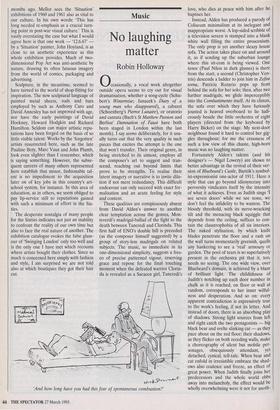Exhibitions 2
The Sixties: Art Scene in London (Barbican Art Gallery, till 13 June)
Lest we forget
Giles Auty
Recently I was criticised by a young woman employed in one of our publicly funded art galleries for not being sufficient- ly knowledgeable about 'punk' culture. What she alleged was incorrect, however, not because I claim any great expertise about even such rudiments of the matter as Mohican haircuts, self-mutilation with safe- ty-pins or torn and filthy clothing but because what she described as a culture is, of course, nothing of the kind. Rather it is 'It's a Man's World l', 1964, by Pauline Boty a state of perpetuated mental and sartorial adolescence, with hardly enough cerebral content to qualify even as a cult or anti-cul- ture.
In the face of the large exhibition, The Sixties: Art Scene in London, at the Barbi- can, I fear many have been too generous by far also in regarding the art in question as some kind of cultural phenomenon. A good deal of this art could hardly have been more shallow, facile and juvenile, and thus will appeal principally to those in whom such characteristics remain particu- larly marked. To those largely ignorant of or even hostile to the great traditions of European art, the works on display at the Barbican may have appeared novel at the time or even deliciously irreverent — roughly the equivalent, perhaps, of pulling silly faces in one of our great Gothic cathe- drals. None the less, a huge nostalgia exists now for the non-culture of the Sixties. Regrettably, this is not confined to pseuds and superannuated hippies, who abound still in our broadcast and other media, nor to those sufficiently young to have missed the whole sorry experience, but extends to many of those whom one might have hoped would know better. Foremost among these is Dr David Mellor of Sussex University who six years ago was the driving force behind the excellent exhibition of Neo- Romantic art at this same venue. The pre- sent exhibition, which he has organised also, has taken him two years to prepare, and he is responsible likewise for the text of a weighty catalogue.
Among the claims made by others for this exhibition is that a number of largely forgotten artists have been dug up for the occasion. But, on the evidence of this show, most were forgotten deservedly. Indeed, if they really were so remarkable, why are so few doing anything of any significance today? By far the best British art of the Six- ties was made by artists who are not repre- sented here. Freud, Bacon, Andrews, Auerbach, Kossoff and others of the School of London would qualify for the show in terms of residence, at least, even if not being part of the so-called London 'scene'. Indeed, the choice of this last word as part of the exhibition's title sums up the shallowness of the whole enterprise, which is characterised by rose-tinted sentimentali- ty for an era that was generally silly, even when not actively harmful. To take only one example, the serious use of drugs was almost unknown in this country before the Sixties. I am sure the inhabitants of a num- ber of our major cities, including a great many parents and members of the police force, would wish that this far-off state of affairs had prevailed. Some would also trace the acccelerated decline of family life to the era of the flared trouser and serious- ly scrambled brain. Thankfully, Dr Mellor's survey does not concern itself solely with Pop, which had more than enough exposure in a huge exhi- bition at the Royal Academy just 18 months ago. Mellor sees the 'Situation' exhibitions of 1960 and 1961 also as vital to our culture. In his own words: 'This has long needed re-emphasis as a crucial turn- ing point in post-war visual culture.' This is vastly overstating the case but what I would agree here is that one work — '12.6.67' — by a 'Situation' painter, John Hoyland, is as close to an aesthetic experience as this whole exhibition provides. Much of two- dimensional Pop Art was anti-aesthetic by nature, drawing its often fatuous imagery from the world of comics, packaging and advertising.
Sculpture, in the meantime, seemed to have turned to the world of shop-fitting for inspiration. The new sculptural language of painted metal sheets, rods and bars employed by such as Anthony Caro and David Annesley has not improved with age, nor have the early paintings of David Hockney, Howard Hodgkin and Richard Hamilton. Seldom can major artistic repu- tations have been forged on the basis of so little visible talent. Works by the 'forgotten' artists resurrected here, such as the late Pauline Boty, Marc Vaux and John Plumb, look even slighter than I remember, which is saying something. However, the subse- quent careers of many others represented here establish that minor, fashionable tal- ent is no impediment to the acquisition later on of key jobs in this country's art- school system, for instance. In this area of education, as in others, we seem obliged to pay lip-service still to reputations gained with such a minimum of effort in the Six- ties.
The desperate nostalgia of many people for the Sixties indicates not just an inability to confront the reality of our own time but also to face the real nature of another. The exhibition catalogue evokes the false glam- our of 'Swinging London' only too well and is the only one I have met which recounts where artists bought their clothes. Since so much is concerned here simply with fashion and style, I am surprised we are not told also at which boutiques they got their hair cut.



























































 Previous page
Previous page